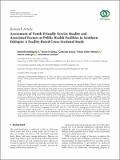| dc.contributor.author | Mulugeta, Betebebu | |
| dc.contributor.author | Girma, Meseret | |
| dc.contributor.author | Kejela, Gemechu | |
| dc.contributor.author | Meskel, Feleke Gebre | |
| dc.contributor.author | Andarg, Eshetu | |
| dc.contributor.author | Zerihun, Eshetu | |
| dc.date.accessioned | 2022-04-11T21:14:02Z | |
| dc.date.available | 2022-04-11T21:14:02Z | |
| dc.date.issued | 2019-05-23 | |
| dc.identifier.citation | Mulugeta, B.A., Girma, M., Kejela, G., Meskel, F.G., Andarge, E., & Zerihun, E. (2019). Assessment of Youth-Friendly Service Quality and Associated Factors at Public Health Facilities in Southern Ethiopia: A Facility-Based Cross-Sectional Study. BioMed Research International, 2019. | en_US |
| dc.identifier.other | DOI:10.1155/2019/9696278 | |
| dc.identifier.other | Corpus ID: 168168058 | |
| dc.identifier.uri | https://repository.amref.ac.ke/handle/123456789/655 | |
| dc.description | Copyright © 2019 Betebebu Mulugeta et al. Tis is an open access article distributed under the Creative Commons Attribution
License, which permits unrestricted use, distribution, and reproduction in any medium, provided the original work is properly
cited | en_US |
| dc.description.abstract | Background. Evidence shows that services for youths are poorly coordinated and uneven in quality. Tere is a lack of evidence
which informs the level of youth-friendly service quality in the study area. So, this study flls the information gaps and recommends
practical solutions. Objective. Te main aim of the study was to assess youth-friendly service quality and associated factors at public
health facilities in Arba Minch town, Southern Ethiopia. Methods. Facility-based quantitative cross-sectional study supplemented
with the qualitative design was conducted from September to December 2017 at two public health centers in Arba Minch town.
Sample sizes of 403 young clients were included in the study using a systematic sampling technique. Data was collected by using
an interview-administered questionnaire and observation checklist. Quantitative data analysis was made using SPSS version 20.0
to identify the association between the dependent and independent variables. Qualitative fndings were coded and analyzed by
using content analysis in Microsof Excel. Finally, results are presented using narrations, tables, and fgures. Results. A total of 403
youth-friendly service clients participated in the study. Te overall score input, process, and youth clients’ satisfaction was 54.41%,
42.0%, and 49.1%, respectively. Age (15-19) [AOR (95% CI) = 3.2 (1.4-7.8)], employment [AOR (95% CI) = 6.4 (2-17)], place of YFS
[AOR (95% CI) = 0.35 (0.1-0.8)], frequency of visit [AOR (95% CI) = 0.03 (0.0-0.3)], waiting time [AOR (95% CI) = 0.02 (0.0-
0.09)], and comfort with providers’ sex [AOR (95% CI) = 0.07 (0.02-0.2)] were factors which are signifcantly associated with client
satisfaction in this study. Conclusion and Recommendation. Te study revealed that the overall quality of youth-friendly health
service is below-set criteria (not good quality) in its all components, i.e., structural, process, and output. So, improvement of facility
setup, client-provider interaction, and service sensitivity to all young groups and waiting time of services is essential. | en_US |
| dc.description.sponsorship | ArbaMinch University | en_US |
| dc.language.iso | en | en_US |
| dc.publisher | Hindawi | en_US |
| dc.subject | Adolescents | en_US |
| dc.subject | Young people | en_US |
| dc.subject | Alcohol or tobacco use | en_US |
| dc.subject | Youth-Friendly Service | en_US |
| dc.title | Assessment of Youth-Friendly Service Quality and Associated Factors at Public Health Facilities in Southern Ethiopia_A Facility-Based Cross-Sectional Study | en_US |
| dc.type | Article, Journal | en_US |

